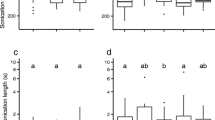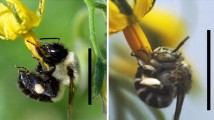Abstract
Buzz-pollination is a plant strategy that promotes gamete transfer by requiring a pollinator, typically bees (Hymenoptera: Apoidea), to vibrate a flower’s anthers in order to extract pollen. Although buzz-pollination is widespread in angiosperms with over 20,000 species using it, little is known about the functional connection between natural variation in buzzing vibrations and the amount of pollen that can be extracted from anthers. We characterized variability in the vibrations produced by Bombus terrestris bumblebees while collecting pollen from Solanum rostratum (Solanaceae), a buzz-pollinated plant. We found substantial variation in several buzzing properties both within and among workers from a single colony. As expected, some of this variation was predicted by the physical attributes of individual bumblebees: heavier workers produced buzzes of greater amplitude. We then constructed artificial “pollination buzzes” that varied in three parameters (peak frequency, peak amplitude, and duration), and stimulated S. rostratum flowers with these synthetic buzzes to quantify the relationship between buzz properties and pollen removal. We found that greater amplitude and longer duration buzzes ejected substantially more pollen, while frequency had no directional effect and only a weak quadratic effect on the amount of pollen removed. These findings suggest that foraging bumblebees may improve pollen collection by increasing the duration or amplitude of their buzzes. Moreover, given that amplitude is positively correlated with mass, preferential foraging by heavier workers is likely to result in the largest pollen yields per bee, and this could have significant consequences for the success of a colony foraging on buzz-pollinated flowers.






Similar content being viewed by others
References
Aicher B, Markl H, Masters WM, Kirschenlohr HL (1983) Vibrational transmission through the walking legs of the fiddler crab, Uca pugilator (Brachyura, Ocypodidae) as measured by laser-Doppler vibrometry. J Comp Physiol A 150:483–491
Anderson GJ, Symon D (1988) Insect foragers on Solanum flowers in Australia. Ann Mo Bot Gard 75:842–852
Bell PD (1980) Transmission of vibrations along plant stems: implications for insect communication. NY Entomol Soc 88:210–216
Bohs L, Olmstead RO (1999) Solanum phylogeny inferred from chloroplast DNA sequence data. In: Nee M, Symon DE, Lester RN, Jessop JP (eds) Solanaceae IV. Royal Botanic Gardens, Kew, pp 97–111
Bowers KAW (1975) The pollination ecology of Solanum rostratum (Solanaceae). Am J Bot 62:633–638
Brian AD (1952) Division of labour and foraging in Bombus agrorum Fabricus. J Anim Ecol 21:223–240
Brooks R, Hunt J, Blows MW, Smith MJ, Bussière LF, Jennions MD (2005) Experimental evidence for multivariate stabilizing sexual selection. Evolution 59:871–880
Buchmann SL (1983) Buzz pollination in angiosperms. In: Jones CE, Little RJ (eds) Handbook of Experimental Pollination Biology. Scientific and Academic Editions, NY, pp 73–113
Buchmann SL (1986) Vibratile pollination in Solanum and Lycopersicon: a look at pollen chemistry. In: D’Arcy WG (ed) Solanaceae: biology and systematics. Columbia University Press, NY, pp 237–252
Buchmann SL, Cane JH (1989) Bees assess pollen returns while sonicating Solanum flowers. Oecologia 81:289–294
Buchmann SL, Hurley JP (1978) Biophysical model for buzz pollination in Angiosperms. J Theor Biol 72:639–657
Cane JH, Buchmann SL (1989) Novel pollen-harvesting behavior by the bee Protandrena mexicanorum (Hymenoptera, Andrenidae). J Insect Behav 2:431–436
Casas J, Magal C, Sueur J (2007) Dispersive and non-dispersive waves through plants: implications for arthropod vibratory communication. Proc R Soc Lond B 274:1087–1092
Cocroft RB, De Luca PA (2006) Size-frequency relationships in insect vibrational signals. In: Drosopolous S, Claridge MF (eds) Insect sounds and communication: physiology, behaviour, ecology and evolution. CRC, Boca Raton, pp 109–120
Cocroft RB, Rodrìguez RL (2005) The behavioral ecology of insect vibrational communication. Bioscience 55:323–334
Cocroft RB, Tieu TD, Hoy RR, Miles RN (2000) Directionality in the mechanical response to substrate vibration in a treehopper (Hemiptera: Membracidae: Umbonia crassicornis). J Comp Physiol A 186:695–705
Cökl A, Presern J, Virant-Doberlet M, Bagwell GJ, Millar JG (2004) Vibratory signals of the harlequin bug and their transmission through plants. Physiol Entomol 29:372–380
Connolly BA, Anderson GJ (2003) Functional significance of the androecium in staminate and hermaphroditic flowers of Solanum carolinense (Solanaceae). Plant Syst Evol 240:235–243
Corbet SA, Chapman H, Saville N (1988) Vibratory pollen collection and flower form: bumble-bees on Actinidia, Symphytum, Borago and Polygonatum. Funct Ecol 2:147–155
Draper NR, John JA (1988) Response-surface designs for quantitative and qualitative variables. Technometrics 30:423–428
Dukas R, Dafni A (1990) Buzz-pollination in 3 nectariferous Boraginaceae and possible evolution of buzz-pollinated flowers. Plant Syst Evol 169:65–68
Endress PK (1994) Diversity and evolutionary biology of tropical flowers. Cambridge University Press, Cambridge
Free JB (1955) The division of labour within bumblebee colonies. Insectes Soc 2:195–212
Furrer R, Nychka D, Sain S (2010) Tools for spatial data. R package versioin 6.3 (http://CRAN.R-project.org/package=fields)
Goulson D (2010) Bumblebees: behaviour, ecology, and conservation (2nd edn). Oxford University Press, New York
Goulson D, Peat J, Stout JC, Tucker J, Darvill B, Derwent LC, Hughes WOH (2002a) Can alloethism in workers of the bumblebee Bombus terrestris be explained in terms of foraging efficiency? Anim Behav 64:123–130
Goulson D, Stout JC, Kells AR (2002b) Do alien bumblebees compete with native flower-visiting insects in Tasmania? J Insect Conserv 6:179–189
Goulson D, Hanley ME, Darvill B, Ellis JS, Knight ME (2005) Causes of rarity in bumblebees. Biol Conserv 122:1–8
Harder LD (1990) Behavioral responses by bumble bees to variation in pollen availability. Oecologia 85:41–47
Harder LD, Barclay MR (1994) The functional significance of poricidal anthers and buzz pollination: controlled pollen removal from Dodecatheon. Funct Ecol 8:509–517
Harder LD, Thomson JD (1989) Evolutionary options for maximizing pollen dispersal of animal-pollinated plants. Am Nat 133:323–344
Heinrich B (1979) Bumblebee economics. Harvard University Press, Cambridge
Henry CS, Martinez-Wells ML (2004) Adaptation or random change? The evolutionary response of songs to substrate properties in lacewings (Neuroptera: Chrysopidae: Chrysoperla). Anim Behav 68:879–895
Hill PSM (2008) Vibrational communication in animals. Harvard University Press, Cambridge
Jesson LK, Kang J, Wagner SL, Barrett SCH, Dengler NG (2003) The development of enantiostyly. Am J Bot 90:183–195
Kawai Y, Kudo G (2009) Effectiveness of buzz pollination in Pedicularis chamissonis: significance of multiple visits by bumblebees. Ecol Res 24:215–223
King MJ (1993) Buzz foraging mechanism in bumble bees. J Apic Res 32:41–49
King MJ, Buchmann SL (1996) Sonication dispensing of pollen from Solanum laciniatum flowers. Funct Ecol 10:449–456
King MJ, Buchmann SL (2003) Floral sonication by bees: mesosomal vibration by Bombus and Xylocopa, but not Apis (Hymenoptera: Apidae), ejects pollen from poricidal anthers. J Kans Entomol Soc 76:295–305
King MJ, Buchmann SL, Spangler HG (1996) Activity of asynchronous flight muscle from two bee families during sonication (buzzing). J Exp Biol 199:2317–2321
Knapp S, Persson V, Blackmore S (1998) Pollen morphology and functional dioecy in Solanum (Solanaceae). Plant Syst Evol 210:113–139
Knapp S, Bohs L, Nee M, Spooner DM (2004) Solanaceae—a model for linking genomics with biodiversity. Comp Funct Genom 5:285–291
Lande R, Arnold SJ (1983) The measurement of selection on correlated characters. Evolution 37:1210–1226
Larson BM, Barrett SCH (1999) The ecology of pollen limitation in buzz-pollinated Rhexia virginica (Melastomataceae). J Ecol 87:371–381
Lester RN, Francisco-Ortega J, Al-Ani M (1999) Convergent evolution of heterandry (unequal stamens) in Solanum, proved by spermoderm SEM. In: Nee M, Symon DE, Lester RN, Jessop JP (eds) Solanaceae IV. Royal Botanical Gardens, Kew, pp 51–69
Lye GC, Kaden JC, Park KJ, Goulson D (2010) Forage use and niche partitioning by non-native bumblebees in New Zealand: implications for the conservation of their populations of origin. J Insect Conserv 14:607–615
Macior LW (1964) Experimental study of floral ecology of Dodecatheon meadia. Am J Bot 51:96–108
Macior LW (1974) Behavioral aspects of coadaptations between flowers and insect pollinators. Ann Mo Bot Gard 61:760–769
McNett GD, Cocroft RB (2008) Host shifts favor vibrational signal divergence in Enchenopa binotata treehoppers. Behav Ecol 19:650–656
McNett GD, Miles RN, Homentcovschi D, Cocroft RB (2006) A method for two-dimensional characterization of animal vibrational signals transmitted along plant stems. J Comp Physiol A 192:1245–1251
Michelsen A, Fink F, Gogala M, Traue D (1982) Plants as transmission channels for insect vibrational songs. Behav Ecol Sociobiol 11:269–281
Morris GK (1980) Calling display and mating behaviour of Copiphora rhinoceros Pictet (Orthoptera: Tettigoniidae). Anim Behav 28:42–51
Peat J, Goulson D (2005) Effects of experience and weather on foraging efficiency and pollen versus nectar collection in the bumblebee, Bombus terrestris. Behav Ecol Sociobiol 58:152–156
Peat J, Tucker J, Goulson D (2005) Does intraspecific size variation in bumblebees allow colonies to efficiently exploit different flowers? Ecol Entomol 30:176–181
Pouvreau A (1989) Contribution à l’étude du polyéthisme chez les bourdons, Bombus Latr. (Hymenoptera, Apidae). Apidologie 20:229–244
R Core Development Team (2010) R: A language and environment for statistical computing. R foundation for statistical computing, Vienna
Rasheed SA, Harder LD (1997a) Economic motivation for plant species preferences of pollen-collecting bumble bees. Ecol Entomol 22:209–219
Rasheed SA, Harder LD (1997b) Foraging currencies for non-energetic resources: pollen collection by bumblebees. Anim Behav 54:911–926
Roulston TH, Cane JH, Buchmann SL (2000) What governs protein content of pollen: pollinator preferences, pollen-pistil interactions, or phylogeny? Ecol Monogr 70:617–643
SAS Institute (2007) JMP IN: the statistical discovery software: release 7.0. SAS Institute, Cary, North Carolina
Schluter D, Nychka D (1994) Exploring fitness surfaces. Am Nat 143:597–616
Thorp RW (2000) The collection of pollen by bees. Plant Syst Evol 222:211–223
Vallejo-Marin M, Manson JS, Thomson JD, Barrett SCH (2009) Division of labour within flowers: heteranthery, a floral strategy to reconcile contrasting pollen fates. J Evol Biol 22:828–839
Vallejo-Marin M, Da Silva EM, Sargent RD, Barrett SCH (2010) Trait correlates and functional significance of heteranthery in flowering plants. New Phytol 188:418–425
Vogel S (1978) Evolutionary shifts from reward to deception in pollen flowers. In: Richards AJ (ed) The pollination of flowers by insects. Academic, London, pp 89–96
Whalen MD (1979) Taxonomy of Solanum section Androceras. Gentes Herb 11:359–426
Wolf TJ, Ellington CP, Begley IS (1999) Foraging costs in bumblebees: field conditions cause large individual differences. Insectes Soc 46:291–295
Zar JH (1984) Biostatistical analysis, 2nd edn. Prentice-Hall, New Jersey
Acknowledgments
We thank D. Boles for providing assistance with laser recordings, plant care, and bumblebee maintenance, and G. McLeod for SEM assistance. This study was funded in part by a Royal Society of Edinburgh International Travel Grant to L.F.B. and P.A.D., a Carnegie Trust Undergraduate Vacation Scholarship to D. Boles, a BES (University of Stirling) Undergraduate Vacation Scholarship to D.S.V. and a Royal Society of London Research Grant (RG2010R1) to M.V.M. This manuscript was improved by comments provided by two anonymous reviewers. The experiments conform to the current laws of the University of Stirling and the UK.
Author information
Authors and Affiliations
Corresponding author
Additional information
Communicated by Diethart Matthies.
Rights and permissions
About this article
Cite this article
De Luca, P.A., Bussière, L.F., Souto-Vilaros, D. et al. Variability in bumblebee pollination buzzes affects the quantity of pollen released from flowers. Oecologia 172, 805–816 (2013). https://doi.org/10.1007/s00442-012-2535-1
Received:
Accepted:
Published:
Issue Date:
DOI: https://doi.org/10.1007/s00442-012-2535-1




